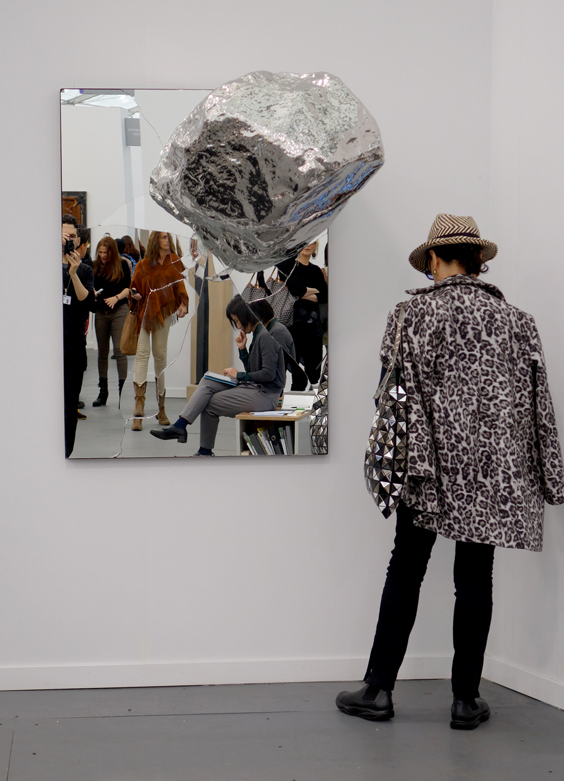
Zhan Wang, Flying Stone No.2, 2007 at Long March Space, Beijing. Photo: M-KOS
Frieze New York 2014 returned from May 9 to 12 for a third consecutive year, taking residence once more on Randall’s Island, flanked between Northern Manhattan and Queens on East river. Tortuously accessible from either a ferry ride leaving just south of the United Nations building (East Mid Town); a school bus journey starting opposite Guggenheim Museum; or via an elaborate drive thought some of New York’s most convoluted overpasses – the journey to Frieze already imposes itself as a pilgrimage for art enthusiasts. Aptly enough, Randall’s Island is also noted for housing several sport fields and a psychiatric asylum, an anecdote thus foretelling of the experience waiting within the winding all-white tent, designed by Brooklyn-based architect duo SOL-IL and the scores of art bounty to behold, simultaneously testing one’s physical stamina and intellectual capacities.
As expected, the Deutsche Bank sponsored fair gathered a most impressive schedule, consolidated with a total of 190 contemporary gallery presentations from around the globe – of which 53 were local to New York City. Younger art spaces launched less than ten years ago were fostered under the Focus section, showing works exclusively programmed for Frieze. The Frame wing targeted even younger galleries – established less than six years ago – to introduce solo artist presentations with the assistance of established curators Raphael Gygax and Tim Saltarelli. Alongside seven newly commissioned site-specific works for Frieze Projects, curated by Cecilia Alemani, featured a special tribute to Allen Ruppersberg’s Al’s Grand Hotel, as well as a series of audio works for Frieze Sounds. The jam-packed Frieze Talks program advertised an impressive line-up of speakers between Pussy Riot’s Nadya Tolokonnikova and dOCUMENTA 14 Artistic Director Adam Szymczyk. Although most of the restaurants, cafes and bars seemed to cater largely to the budgets of wealthy collectors, Frieze did invite three New York-based non-profit centres (The Artist’s Institute, Artists Space and White Columns), to recognise their support of emerging and under-acknowledged contemporary artists.
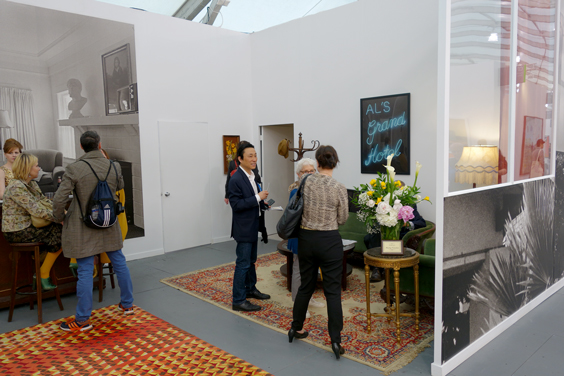
Frieze Project special tribute to Allen Ruppersberg’s “Al’s Grand Hotel”. Photo: M-KOS
More than anything else, this expansive volume of highly consumable – but well organised – works assembled by leading art spaces, artists and curators allowed for the attending public to capture the current zeitgeist of the art world, to literally take a macroscopic snapshot of this specific moment in time, occurring in today’s art ecosystem. Inadvertently, the process of building this year’s monumental slide show unveiled a certain number of patterns. From the cornucopia of works presented, M-KOS was able to identify seven trends worth mentioning below, to enumerate them in a manner not so far from the sometimes humorous listings appearing in the pages of the fair’s eponymous sister magazine.
1. Mirrors
Mirrors as central building materials were literally peppered everywhere in this year’s Frieze New York, between the chrome painted sculptures of Xavier Veilhan’s Lautner (Galerie Perrotin, Paris/NY), the broken surfaces of Zhan Wang’s Flying Stone No.2 (Long March Space, Beijing) and the reverberating infinite illusions of Iván Navarro’s Open Ended (Paul Kasmin Gallery, NY), or Sarah Oppenheimer’s trompe l’oeil reflections (P.P.O.W., NY). Other than for bouncing back the self-love of certain collectors, perhaps mirrors are so popular now since Pistoletto’s wildly successful broken glass pieces, monumentally framed and so well represented in previous fairs.
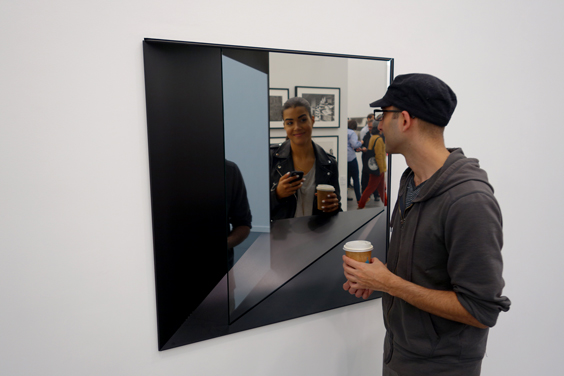
Sarah Oppenheirmer at P.P.O.W. New York. Photo: M-KOS
2. Self-standing DIY structures
Often made up of recycled materials, discarded doors and a surprising amount of strings and containers, such structure could be found in about one in every ten booth throughout the fair, to produce a wide variety of stylistic effects, from the dry minimalism of Virginia Overton’s Untitled (Sandbag) (Mitchell-Innes & Nash, NY) and Untitled (O.M. brick) (White Cube, London/HK/São Paulo), to more expressive examples such as Lizzie Fitch/Ryan Trecartin’s Summer Law (Andrea Rosen Gallery, NY), and the junk heap assemblages of Sam Goodman’s The Bomb and TV (The Box, LA).
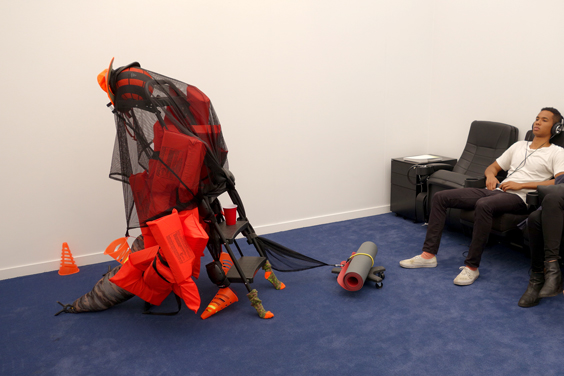
Lizzie Fitch/Ryan Trecartin, Summer Law, 2013 at Andrea Rosen Gallery, New York. Photo: M-KOS
3. Metal wires
Surely everyone at some point acknowledged the importance of tearing down the wall between art and non-art, but did we miss the memo requiring these boundaries to be recycled into high profile art? Arguably every turn around Frieze’s booths could make one stumble on something involving chicken fence (Leonore Antunes, Anni at Marc Foxx Gallery, LA), metal tabletops (Dave McKenzie, The Past Into Future Infinity at Wien Lukatsch, Berlin), linear volumes (Nairy Baghramian, Waste Basket at Galerie Buchholz, Cologne) and more. Surprisingly, barbed wires were nowhere to be seen this year, perhaps denying any connotations to war into the homes of collectors, even in a humorous gesture.
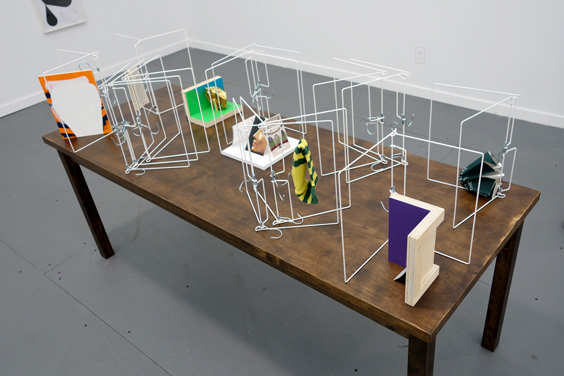
Dave McKenzie, The Past Into Future Infinity, 2012 at Wien Lukatsch, Berlin. Photo: M-KOS
4. Collages
Akin to the self-standing volumes, flat broken-up imagery from multiple sources were all the rage at Frieze’s 2014 edition, whether encased in Perspex sheets, framed or pasted directly on the temporary booth walls. Seeing these in the present decade could possibly indicate a second coming of post-modernism’s eclectic aesthetics or more simply confirm the globalising millennial approach in the works of Geffrey Farmer (Casey Kaplan, NY/Catriona Jefferies, Vancouver), Michele Abeles (Sadie Coles HQ, London), Julia Wachtel (Elizabeth Dee, NY), and the more elegant works of Erin Shirreff (Sikkema Jenkins & Co., NY).
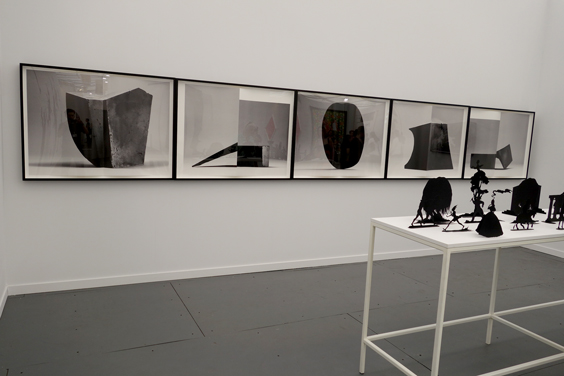
Erin Shireff (left), Kara Walker (Right) at Sikkema Jenkins & Co., New York. Photo: M-KOS
5. Introspective Videos
Video has now come full circle since the dizzying moshes of Paik’s mature edits, now taking a turn towards another media master: Bill Viola. Although the latter could not be seen on any booth, his presence was clearly acknowledged in the works of a younger generation of video artists, such as the quasi-still faces of Zhang Peili (Boers-Li Gallery, Beijing), animated bank note of Jeon Joonho (Gallery Hyundai, Seoul) and the unhung monitors of Nate Boyce (Altman Siegel, San Francisco). Of the markedly increased presence of video works, more than half were slow moving, meditative, and mostly displaying a narrow range of colours, a lot of them blue, even.
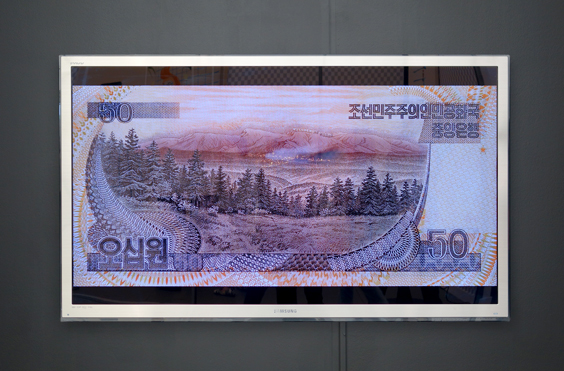
Jeon Joonho, Welcom, 2009 at Gallery Hyundai, Seoul. Photo: M-KOS
6. Nouveau folk art
Sometimes proposed as a faux naïve design by European/American artists emulating Gauguin’s fauvism, thankfully most of the works here were rather channelled through artist of non-Western traditions, whether currently based in the West or not. This increasingly popular motif was best exemplified at this year’s Frieze by the elaborate fabrics and bells worn on Nick Cave’s mannequins (Jack Shainman Gallery, NY), the ‘brut’ heads of Klara Kristalova (Galleri Magnus Karlsson, Stockholm) and the sumptuous collaboration between Damien Deroubaix, Meschac Gaba and Otobong Nkanga, revamping the entire booth design of In Situ – Fabienne Leclerc, Paris.
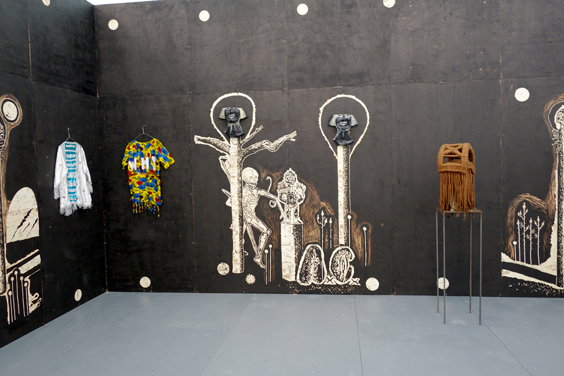
Damien Deroubaix, Meschac Gaba at In Situ – Fabienne Leclerc, Paris. Photo: M-KOS
7. One color objects
Whether free standing volumes or flatter wall reliefs, a significant proportion of the objects found at the fair in this edition seemed to have scaled down the number of colours to display, many of these venturing in bold primaries, others in neutral greys, onto the smashed up cars of Sylvie Fleury (Salon 94, NY) to Roxy Paine’s maple tone chainsaw (Marianne Boesky Gallery, NY), and Lutz Bacher’s The Devil Made Me Do It (Greene Naftali, NY).
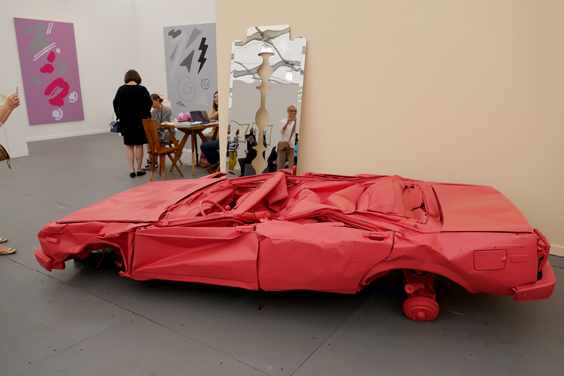
Sylvie Fleury, Skin Crime 3 (Givenchy 318), 1997 at Salon 94, New York. Photo: M-KOS
Needless to say, those subscribing to the above creative directions certainly retain as much originality and talent as any other artist, defending more personal styles. Imposing one’s aesthetic authority within a group can indeed prove much more demanding than when locked inside an ivory studio. Likewise, not only do paradigmatic ideas and forms seem to permeate between creative peers, but these seem also increasingly exchanged with critics, curators, gallerists and other art professionals. To notice emerging patterns thus nowadays reveals more about the preoccupations of an entire contemporary art community then the so-called genius minds of a small number of makers. In this vein, Frieze’s Pommery award for the most innovative fair stand, given to London’s greengrassi gallery, was deliberated by international panel: Pablo León de la Barra, Curator, Guggenheim UBS MAP, Latin America; James Rondeau, Curator of Modern and Contemporary Art, The Art Institute of Chicago; and Ali Subotnick, Curator, The Hammer Museum at UCLA.
Still, by the time this article hits the published sphere, most global art fair trekkers will have already booked their next travel destinations to Eastern shores, as the next must-be-there art fair rendez-vous turns to Art Basel Hong Kong. In the meantime, the M-KOS team can only speculate if the above trends will persist long enough to travel from the Big Apple to the Pearl of the Orient.
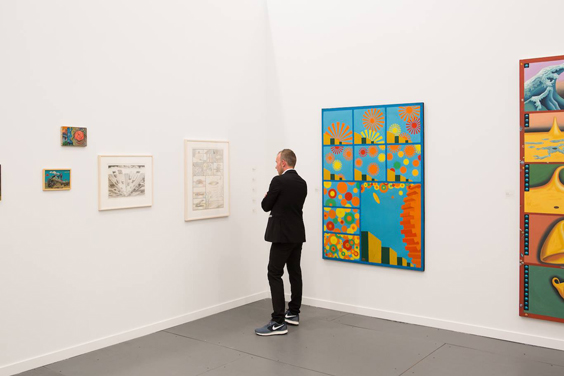
The winner of the Stand Prize 2014, presented by Champagne Pommery, is greengrassi, London. Image courtesy Frieze New York.

Hi Miwa,
That’s an intriguing list! It’s certainly been interesting to trace the evolution of mirror in contemporary art…and collage. Keep up the great blog!
Hi Andrea,
ThanX for your positive feedback!